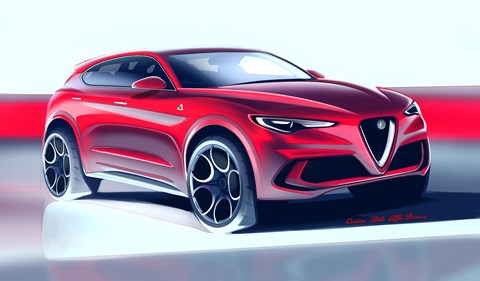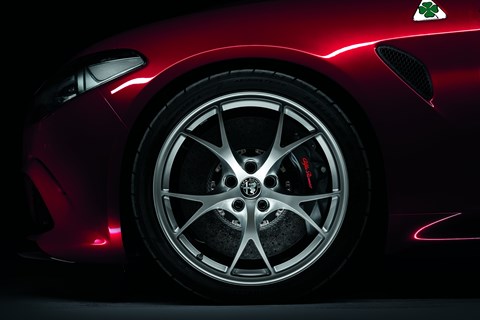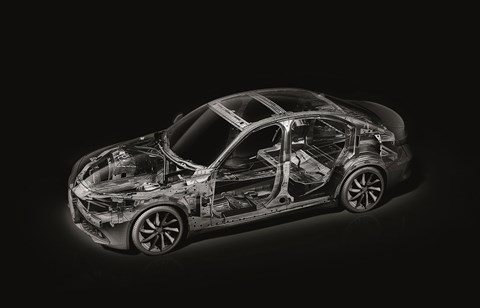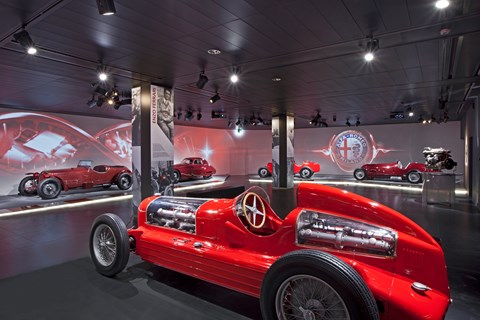► Alfa Romeo: the future
► The Stelvio is just the start
► CEO’s six-point plan revealed
Reid Bigland is the man tasked with taking Alfa Romeo from niche player to global premium brand. The renaissance began with Giulia and continued with the new Stelvio crossover (above), unveiled at the 2016 LA motor show.
Here’s how he plans to finish the job. It’s his six-point plan to make Alfa Romeo great again.
Click here for our full interview with Reid Bigland.
1) Consider everything, even if that means a range of Alfa SUVs

The Stelvio is Alfa’s first SUV: it will not be its last. ‘We’re on track to have eight products out by 2022 – that is our commitment to relaunching Alfa Romeo as a premium brand,’ says Bigland. ‘And if the consumer’s preference continues to gravitate toward SUVs of all shapes and sizes, compact and full-size, then we need to reflect that in the future Alfa product portfolio.
‘Same with Maserati – Levante is going to be close to 50% of Maserati’s volume in 2017. If you’d predicted that 10 years ago people would have said you’re crazy. But with Maserati and Alfa it’s important that we build SUVs that drive and perform like a saloon.’
2) Aim high

Porsche’s Macan is an immensely capable car, one that somehow silences the contradiction most assumed was intrinsic in the concept of a performance SUV. With the Stelvio, Bigland has unashamedly targeted the Porsche.
‘If we can achieve just some of the success the Macan we’ll be in a good place – it’s a phenomenal vehicle, and you see that in the consumer reaction to it,’ he says. ‘The Stelvio project was begun 6-9 months after we started on the Giulia and the timing of its release is particularly good: the mid-size SUV market is really hot.
‘One of the strongest is the Macan. And we’re offering 65 more horsepower and a driving experience that’s a cut above in terms of acceleration and on-track performance. It’s key that we deliver on the performance characteristics of an Alfa Romeo.
‘The Stelvio QF goes 0-60mph in less than 4.0sec, which is unique in the SUV segment, and from our simulations we anticipate it being the fastest SUV in the world around the Nordschleife, just as the Giulia is the fastest saloon. That combination of art, technology and incredible differentiates us.’
3) Get the cars right: sales will take care of themselves

‘We’re not looking to smash any sales records with Alfa Romeo or with Maserati,’ says Bigland. ‘The success of Alfa Romeo will be measured on the extent to which we meet our key attributes: performance, state-of-the-art technology and the gorgeous Italian design. If we can do that then sales success ad profitability will take care of themselves. I’m not fixated on sales targets.
‘This is not a brand we can resurrect, certainly in the US, in 12 or 18 months. We must focus on the product. With Levante we did that and sales last month were up 52% globally last month [October 2016]. Sales figures for the Stelvio? I’m not going to make any predictions, especially for the QV version. Up there, the air gets a little thinner. Not everybody is going to be driving a 503bhp, 0-60mph in 3.9sec SUV. It’s not everyone’s cup of tea – though I happen to like it…’
4) Let the brand guide the thinking

Bigland talks a lot about being true to the Alfa brand. While some would argue that the Stelvio is a pretty good example of not doing that, there’s logic in letting Alfa’s values steer the marque’s course through this transformative era. Take autonomous systems, something the Stelvio is conspicuously light on.
‘They’re the polar opposite of what Alfa Romeo stands for,’ counters Bigland. ‘In an Alfa the driver is an integral part of the vehicle, and wants to be an integral part of the vehicle. If there is a threat from the autonomous driving movement then I think brands like Alfa Romeo, Ferrari and Maserati are not threatened. People are buying those cars to drive them. The mass-market segments – cars concerned with getting somebody from A to B – those are the ones that will be most affected if by this disrupter. Alfa is insulated.’
5) Keep Alfa sacred

The all-new Giorgio platform (above) underpinning the Giulia and Stelvio is, in Bigland’s words, something of ‘a gem’. But rather than immediately roll it out across FCA’s portfolio, he’s keen to keep Alfa Romeo separate and special.
‘When you look at the infotainment and navigation, it’s unique to Alfa – it was part of the skunkworks process and we didn’t want to bring mass-market technology into the next generation of Alfa Romeo,’ explains Bigland. ‘Alfa Romeo is hived off in terms of technology, sharing more with Ferrari and Maserati. But there could be trickle-down to other FCA products.
‘The Giorgio platform is class-leading from a driving dynamics perspective, and a significant competitive advantage for Alfa Romeo, so it is going to be difficult to keep that unique to Alfa: that’s the balance we’ve got strike. We need to be true to the premium values we’re looking to establish. But I can see components of that platform going onto other FCA products, upstream or downstream – it could go both ways.’
6) Don’t worry about racing just yet – stay focused

Alfa has a glorious competition history: F1 dominance in the 1950s, endurance racing success in the 1970s and an almost constant presence in production-based race series with cars like the original Giulia, the 155 and the 156. But Bigland’s focus for now at least is on the road.
‘We have our Alfa logo on the Ferrari F1 car but that’s about as close as we get at the moment – we’re there in spirit, though I’m not sure how much luck we’re bringing them this year. [The cloverleaf logo was first used by superstitious Alfa pilot Ugo Sivocci to bring good luck].
‘Everyone is familiar with Alfa’s history and its racing success but right now let’s focus on getting the Giulia and the Stelvio launched around the world.’
Click here for the full story on the new Alfa Romeo Stelvio